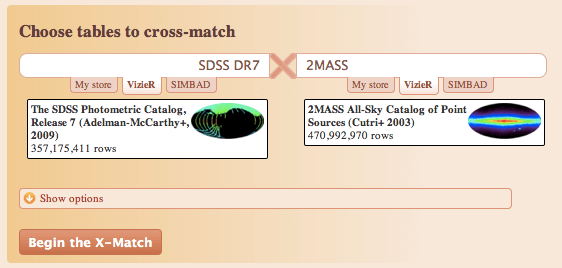
The CDS xMatch (cross-match) service is a tool allowing astronomers to efficiently cross-identify sources between very large catalogues (up to a few billion rows) or between a user-uploaded list of positions and a large catalogue.
This page describes the main aspects of the service. You can also find detailed information on pages dedicated to :
- the parameters and algorithms used by the service.
- an http API, for scripting queries.
- the history of modifications : addition or modification of large catalogues and upgrades to the xMatch service. Also check the dedicated FAQ.
Requirements
Users interact with the CDS xMatch service through a Web application which should run fine on any recent Web browser having Javascript and cookies enabled. This includes Firefox, Chrome, Opera, Safari and Internet Explorer 8+.
The service is open to anonymous users, but we encourage people to register to the CDS services, using the Register link at the top right of the Web page.

We might in the future impose different usage policies for the xMatch service between anonymous and registered users.
Available tables
Available tables are the following:
-
All 25,000+ VizieR tables with position. For each VizieR table, we have kept the default VizieR columns plus positional errors, photometry columns and associated errors if they were not already included.
-
SIMBAD. A view of the SIMBAD bibliographical database with the following fields: main object name, position, errors on position, BVRJHK magnitudes, object type, proper motion, spectral type, and number of bibliographical references. This view is updated each day, so that it reflects the latest updates in the database.
-
user-uploaded tables. You can upload your own table in one of the following formats : VOTable, FITS table or CSV (Comma Separated Values) table (see the FAQ for more details).
Large VizieR tables
Large tables (larger than 10 million rows) have been modified with respect to original VizieR tables. Positional errors have been reformatted to be expressed as an ellipse with 3 parameters: major axis, minor axis and position angle.
Below is the list of available fields for each large VizieR table:
-
2MASS:
2MASSidentifier, position (RAJ2000,DEJ2000) and positional errors (errHalfMaj,errHalfMin,errPosAng),Jmag,Hmag,Kmag,e_Jmag,e_Hmag,e_Kmag,Qfl,Rfl,X,MeasureJD. -
2MASS6X:
2MASSidentifier, positionra,decand positional errors (errHalfMaj,errHalfMin,errPosAng),Jmag,Hmag,Kmag,e_Jmag,e_Hmag,e_Kmag,Qflg,Rflg,Xflg,date,gcntr,l,b,Jsig,Hsig,Ksig,Jsnr,Hsnr,Ksnr,USNO-A2.0,Dopt,PAopt,Bmag,Rmag,Nopt,Bflg,Cflg,Aflg,Ndet,cat,rel. -
CMC14:
CMC14identifier, position (RAJ2000,DEJ2000) and positional errors (errHalfMaj,errHalfMin,errPosAng),r.mag,e_mag,Ep,Nt,Jmag,Hmag,Ksmag. -
DENIS:
DENISidentifier, position (RAJ2000,DEJ2000) and positional errors (errHalfMaj,errHalfMin,errPosAng),Imag,Jmag,Kmag,e_Imag,e_Jmag,e_Kmag,Image,Strip,Obs.JD -
GLIMPSE:
GLIMPSEidentifier, position (RAJ2000,DEJ2000) and positional errors (errHalfMaj,errHalfMin,errPosAng),3.6mag,4.5mag,5.8mag,8.0mag,e_3.6mag,e_4.5mag,e_5.8mag,e_8.0mag. -
GSC 2.3:
GSC23identifier, position (RAJ2000,DEJ2000) and positional errors (errHalfMaj,errHalfMin,errPosAng),Fmag,jmag,Vmag,Nmag,Umag,Bmag,e_Fmag,e_jmag,e_Vmag,e_Nmag,e_Umag,e_Bmag,Epoch,Cl. -
IRSF MCPS:
IRSFidentifier, position (RA,Dec),Jmag,Hmag,Ksmag,e_Jmag,e_Hmag,e_Ksmag,S,Qual,pflg,aflg,Jep,Jshrp,Jchi,XposJ,YposJ,Jregion,Hep,Hshrp,Hchi,XposH,YposH,Hregion,Ksep,Ksshrp,Kschi,XposKs,YposKs,Ksregion,MJD. -
KIC:
KICidentifier, position (RA,Dec),umag,gmag,rmag,imag,zmag,Jmag,Hmag,Kmag,kepmag,pmRA,pmDec,sg,v,aq,fc. -
LMCPS: position (
ra,dec),Umag,Bmag,Vmag,Imag,e_Umag,e_Bmag,e_Vmag,e_Imag,flag. -
NOMAD:
NOMAD1.0identifier, position (RAJ2000,DEJ2000) and positional errors (errHalfMaj,errHalfMin,errPosAng),Bmag,Vmag,Rmag,Jmag,Hmag,Kmag,YM,r,pmRA,pmDE,spRA,spDE. -
PPMX:
PPMX_Jnameidentifier, position (RAJ2000,DEJ2000) and positional errors (errHalfMaj,errHalfMin,errPosAng),Bmag,Vmag,Jmag,Hmag,Kmag,e_Bmag,e_Vmag,e_Jmag,e_Hmag,e_Kmag,pmRA,pmDE,epRA,epDE,epma,epmd,Cmag,Rmag,GoodLSQfit,SubSet. -
PPMXL:
PPMXL_IDidentifier, position (RAJ2000,DEJ2000) and positional errors (errHalfMaj,errHalfMin,errPosAng),Jmag,Hmag,Kmag,e_Jmag,e_Hmag,e_Kmag,pmRA,pmDE,epRA,epDE,epma,epmd,b1mag,b2mag,r1mag,r2mag,imag,fl. -
SDSS DR7:
JNAMEidentifier, position (ra,dec) and positional errors (errHalfMaj,errHalfMin,errPosAng),JNAME,ra,dec,errHalfMaj,errHalfMin,errPosAng,u,g,r,i,z,u_err,g_err,r_err,i_err,z_err,cl,objID,ObsDate. For this table, we only kept primary sources (ie with mode=1) -
SDSS DR8: position (
ra,dec) and positional errors (errHalfMaj,errHalfMin,errPosAng),u,g,r,i,z,u_err,g_err,r_err,i_err,z_err,objID,type,clean,flags,qualityandmjd_medwhich is the median value of mjd_X where X = u, g, r, i and z. -
Tycho2: position (
RA,DE) and positional errors (errHalfMaj,errHalfMin,errPosAng),BTmag,VTmag,TYC1,TYC2,TYC3,pmRA,pmDE,HIP. -
UCAC3:
3UCidentifier, position (RAJ2000,DEJ2000),radec_err,f.mag,a.mag,e_f.mag,e_a.mag,EpRA,EpDE,ot,d,pmRA,pmDE,e_pmRA,e_pmDE,Jmag,Hmag,Kmag,Bmag,R2mag,Imag,Flag. -
UCAC4:
UCAC4identifier, position (RAJ2000,DEJ2000),radec_err,f.mag,a.mag,e_f.mag,e_a.mag,EpRA,EpDE,ot,d,pmRA,pmDE,e_pmRA,e_pmDE,Jmag,Hmag,Kmag,Bmag,Vmag,Gmag,Rmag. -
UKIDSS-DR6 GPS:
JNameidentifier, position (ra,dec),jAperMag3,hAperMag3,k_1AperMag3,k_2AperMag3,h2AperMag3,jAperMag3Err,hAperMag3Err,k_1AperMag3Err,k_2AperMag3Err,h2AperMag3,sourceID,mode,epoch,mergedClass. -
UKIDSS-DR7 LAS: position (
ra,dec),yAperMag3,j_1AperMag3,hAperMag3,kAperMag3,yAperMag3Err,j_1AperMag3Err,hAperMag3Err,kAperMag3Err,sourceID,epoch,priOrSec,mergedClass. -
UKIDSS-DR8 DXS:
JNameidentifier, position (ra,dec),jAperMag3,kAperMag3,jAperMag3Err,kAperMag3Err,sourceID,mode,mergedClass. -
UKIDSS-DR8 GCS:
JNameidentifier, position (ra,dec),jAperMag3,yAperMag3,jAperMag3,hAperMag3,k_1AperMag3,zAperMag3Err,yAperMag3Err,jAperMag3Err,hAperMag3Err,k_1AperMag3Err,sourceID,mode,epoch,mergedClass. -
UKIDSS-DR8 LAS:
JNameidentifier, position (ra,dec),yAperMag3,j_1AperMag3,hAperMag3,kAperMag3,yAperMag3Err,j_1AperMag3Err,hAperMag3Err,kAperMag3Err,sourceID,mode,epoch,mergedClass. -
USNO-A2.0:
USNO-A2.0identifier, position (RAJ2000,DEJ2000) and positional errors (errHalfMaj,errHalfMin,errPosAng),Bmag,Rmag,GoodPhot,Epoch. -
USNO-B1.0:
USNO-B1.0identifier, position (RAJ2000,DEJ2000) and positional errors (errHalfMaj,errHalfMin,errPosAng),Bmag1,Rmag1,Bmag2,Rmag2,Imag,Epoch,pmRA,pmDE,spA,spD,Flags. -
WISE:
JNAMEidentifier, positions (ra,dec) and positional errors (errHalfMaj,errHalfMin,errPosAng),W1mag,W2mag,W3mag,W4mag,Jmag,Hmag,Kmag,e_W1mag,e_W2mag,e_W3mag,e_W4mag,e_Jmag,e_Hmag,e_Kmag,cntr,cc_flags,ext_flg,var_flg,ph_qual,r_2mass.
Consult the VizieR service for a detailed description of each field above.
Some data have been modified from the original catalogues:
- Positions are given in FK5 J2000 (at epoch 2000 if proper motion available)
- Positional errors have been standardized: they are all given in arcseconds in the form of a circle or an ellipse with semi-minor, semi-major axis and position angle
- For catalogues containing proper motions such as the USNO-B1.0, although positions are given at epoch 2000, positional errors do not take into account proper motion uncertainties (will be done in a future release)
- For all catalogues, and especially the USNO-B1.0, a threshold of 40 has been put on magnitudes: higher values are set to 40. (If it is annoying you, contact us, it can easily be changed).
If those limitations are a problem for you, contact us.
The currently computed position angle (column named
errPosAng) for some catalogue is defined as being north-of-east instead of east-of-north. It affects :
- Gaia DR2 (
I/345/gaia2) and Gaia DR2 Epoch 2015.5. Note that the original error columns are provided in the output.- SDSS DR7 (
II/294/sdss7).The correct position angle is therefore
90 - errPosAngfor those catalogues.
SDSS DR7 and DR8
-
SDSS DR7 : Only primary source (mode=1) and object of type GALAXY or STAR (cl = 3 or 6) are available.
-
SDSS DR8 : Only primary source (mode=1) are available.
GALEX AIS and MIS
Versions of Galex AIS and MIS are the catalogues available here: http://dolomiti.pha.jhu.edu/uvsky/.
UKIDSS DR5
For more informations on UKIDSS, see this page, and this page. For an overview of the parameters, browse this page.
Submitting a cross-match job
Point your browser to http://cdsxmatch.cds.unistra.fr/
Choose tables to cross-match
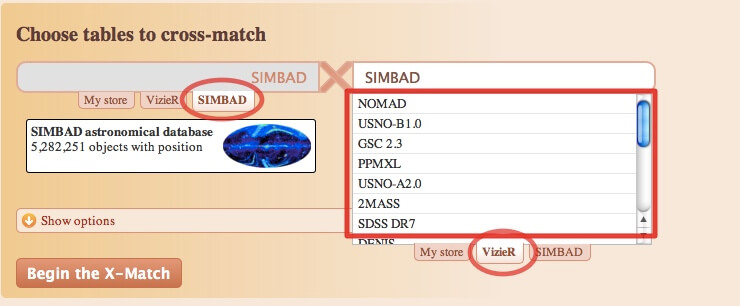
Select the two tables you wish to cross-match with the interface displayed above.
The My store tab lists all your uploaded tables.
If you want to use a VizieR table which is not in the list, simply type
its full name (e.g. I/239/hip_main) in the text box, as shown below:

Choose cross-match method
Click on
 to open the panel
with the cross-match options. This panel allows one to choose the
cross-match method and its parameters.
to open the panel
with the cross-match options. This panel allows one to choose the
cross-match method and its parameters.
You can perform a cross-match based only on the positions, or a cross-match based on positions taking into account error uncertainties.
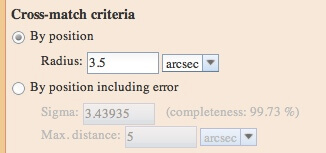
Details on these two methods can be found in the description of Algorithms.
Choose sky area
Cross-match can be performed on all sources of both tables, or can be restricted to a cone around a given position or object name, or to a given HEALPix cell (in NESTED mode, ICRS frame). If an object name is given, its position will be resolved by Sesame.
Choose the sky area you wish from the panel shown below.

See also the section on Cross-match area.
Submit !
Once the tables selected and the options set, click on

Monitoring job progress
Once your job is submitted, you can track its progress at the bottom of
the page.
Your job might be queued
 .
.
Queued jobs wait for a computation worker to be available. When the job is being executed, a progress bar shows the computation progress and another shows the progress of the result generation.
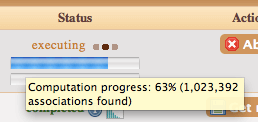
If you are a registered user, you might choose, from your preferences, to receive an email when the computation is over (see below).

Retrieving result
When a job has successfully completed, a short summary of its execution is available by clicking on the info icon.

The histogram of the distances between the computed associations can also be displayed:

If the job has failed, click on See details button to get more information on the error origin.

In order to download the result, click on

The result can be retrieved either as a CSV (comma-separated values), an ASCII (column-aligned) or a VOTable file. In the result, each row is a concatenation of the following fields: distance between catalogue A and catalogue B sources, distance in sigma (if positional errors were taken into account), fields from catalogue A, fields from catalogue B.
Limitations
The following limitations apply to the submitted jobs:
-
Long jobs are aborted if computation exceeds 120 minutes. This should be sufficient for any cross-match job, even for the largest catalogues, if no error happens.
-
Short jobs are aborted if computation exceeds 15 minutes. Short jobs are jobs which are restricted to a cone search of Healpix cell. If the largest table of the job is smaller than 20M rows or if the smallest table is smaller than 150,000 rows, the job is also considered as a short job. All other jobs are long jobs.
-
The maximum search radius is 120 arcsec for a simple cross-match by position
-
When restricting the sky area to a cone-search, the maximum cone radius is 15 degrees.
-
Results are removed from our servers 7 days after their submission.
Uploading a table
You can upload your own table with positions, and use it later in a cross-match job. Your table can be in VOTable, FITS table or CSV format (see the FAQ for an example).
First, click on the Tables management tab:

At the bottom of the page, select on your local disk the table to upload and click on Upload to the store.
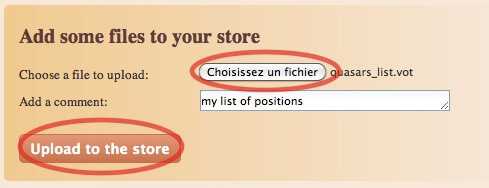 .
.
When the upload process is done, the new table will appear in your store
list.
Before using the uploaded table in a cross-match job, positional
metadata must be set, clicking on
 and selecting the relevant
fields:
and selecting the relevant
fields:
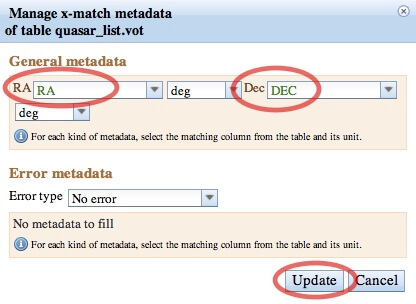
You will also need to set the error metadata if you plan to use this table for cross-match jobs with positional errors.
Please note that the total size of uploaded tables is limited to 100 MB for anonymous users, and 500 MB for registered users.
If you use the storage space, you must comply to the following guidelines:
- only data related to astronomical research might be saved or uploaded to the CDS Portal storage space
- CDS does not assume any responsibility for loss of data. Please backup your important results locally !
- the user storage space must not be considered as a long-term backup facility, but as a convenient facility to facilitate the use of CDS services
- in order to preserve disk space, saved data might be removed if the associated account is inactive for more than 6 consecutive months
Acknowledgements and feedback
Service acknowledgement
If the xMatch service was useful for your research, please consider acknowledging its usage.
Catalogues acknowledgements
Some of the large catalogues have specific acknowledgements, as listed below. This list may not be up-to-date: please consider checking the acknowledgements in the VizieR
ReadMefile associated to each catalogue.
2MASS
The primary journal reference for 2MASS and its image and catalogue data products is:
The Two Micron All Sky Survey (2MASS) M.F. Skrutskie, R.M. Cutri, R. Stiening, M.D. Weinberg, S. Schneider, J.M. Carpenter, C. Beichman, R. Capps, T. Chester, J. Elias, J. Huchra, J. Liebert, C. Lonsdale, D.G. Monet, S. Price, P. Seitzer, T. Jarrett, J.D. Kirkpatrick, J. Gizis, E. Howard, T. Evans, J. Fowler, L. Fullmer, R. Hurt, R. Light, E.L. Kopan, K.A. Marsh, H.L. McCallon, R. Tam, S. Van Dyk, and S. Wheelock, 2006, AJ, 131, 1163.
Please include the following standard acknowledgment in any published material that makes use of 2MASS data products:
This publication makes use of data products from the Two Micron All Sky Survey, which is a joint project of the University of Massachusetts and the Infrared Processing and Analysis Center/California Institute of Technology, funded by the National Aeronautics and Space Administration and the National Science Foundation.
SDSS DR8
Funding for SDSS-III has been provided by the Alfred P. Sloan Foundation, the Participating Institutions, the National Science Foundation, and the U.S. Department of Energy Office of Science. The SDSS-III web site is http://www.sdss3.org/.
SDSS-III is managed by the Astrophysical Research Consortium for the Participating Institutions of the SDSS-III Collaboration including the University of Arizona, the Brazilian Participation Group, Brookhaven National Laboratory, University of Cambridge, Carnegie Mellon University, University of Florida, the French Participation Group, the German Participation Group, Harvard University, the Instituto de Astrofisica de Canarias, the Michigan State/Notre Dame/JINA Participation Group, Johns Hopkins University, Lawrence Berkeley National Laboratory, Max Planck Institute for Astrophysics, Max Planck Institute for Extraterrestrial Physics, New Mexico State University, New York University, Ohio State University, Pennsylvania State University, University of Portsmouth, Princeton University, the Spanish Participation Group, University of Tokyo, University of Utah, Vanderbilt University, University of Virginia, University of Washington, and Yale University.
UCAC4
The paper The fourth U.S. Naval Observatory CCD Astrograph Catalog (UCAC4) by Zacharias N., Finch C.T., Girard T.M., Henden A., Bartlet J.L., Monet D.G., Zacharias M.I., 2013, AJ, 145 44 should be cited whenever UCAC4 data is utilized.UKIDSS
The teams which built WFCAM, processed the data, and implemented the UKIDSS surveys have no proprietary time. When you use UKIDSS data, please credit their efforts with something similar to the following wording:
The UKIDSS project is defined in Lawrence et al (2007). UKIDSS uses the UKIRT Wide Field Camera (WFCAM; Casali et al, 2007). The photometric system is described in Hewett et al (2006), and the calibration is described in Hodgkin et al. (2009). The pipeline processing and science archive are described in Irwin et al (2009, in prep) and Hambly et al (2008).
WISE
Published material that makes use of WISE data products should include the following acknowledgement:
This publication makes use of data products from the Wide-field Infrared Survey Explorer, which is a joint project of the University of California, Los Angeles, and the Jet Propulsion Laboratory/California Institute of Technology, funded by the National Aeronautics and Space Administration.
Feedback
If you have troubles using the CDS xMatch service, or if you have suggestions to improve it, do not hesitate to send us some feedback by email to cds-question@unistra.fr